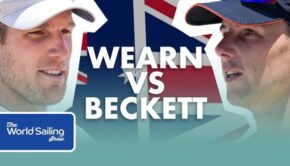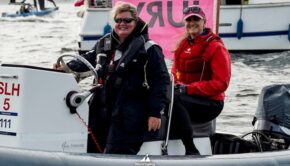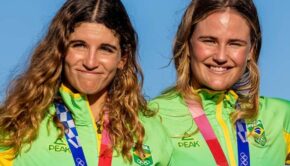World Sailing Council Gets to Business
Published on November 11th, 2016
World Sailing’s 2016 Annual Conference brings together international delegates this week in Barcelona, Spain. Here’s an update from November 11:
World Sailing’s Council met today and received a number of reports over the five-hour session.
World Sailing President Carlo Croce opened the meeting with his report which will be available to watch back on the live YouTube feed. This was followed by reports from each member of the Board of Directors who presented on their responsibilities.
An overview of the session is available below:
Vice President’s Reports
Adrienne Greenwood opened up the Vice President reports by letting World Sailing Council know about the Classes Committee and the compilation of data from class reports from 2012 to 2015. The data has been collected to give an accurate database for an independent assessment of the sport. 460 class reports form the basis of the database.
Under Greenwood’s remit is the Match Racing Committee. She noted the 2016 World Match Racing Tour series and the move into M32s as well as the Women’s International Match Racing Series, which continues to prosper.
The Youth World Match Racing World Championship was held in New Caledonia this year and Greenwood spoke about how the numbers attending were low and that there was a need for accessible venues to ensure ongoing success of the worlds.
Quanhai Li opened up his report by touching on the achievements of Asian sailors at the Rio 2016 Olympic Games. Asian nations such as Japan, South Korea, Thailand, Malaysia, Singapore and China were well represented at Rio 2016.
For Laser Radial sailors, Kamolwan Chanyim of Thailand and Nur Shazrin Mohamed Latif of Malaysia, they qualified their country for the first time in their class.
An overview of the number of sailing events in Asia was given, highlighting how the sport continues to grow in Asia not only in dinghies but also in keelboats.
Vice-President Chris Atkins thanked the world’s Race Officials for continuously providing sailors with good, fair and enjoyable racing. He also spoke about the importance of transparency in appointing race officials and improving I.T. around race official applications and reporting. Atkins briefly touched on events in advance of further discussions to be held during the Council meeting.
Beppe Croce Trophy recipient George Andreadis presented a review of Equipment Inspection at the Rio 2016 Olympic Games and how everything was done to ensure fair sport from equipment inspection, control and distribution.
Coming to the end of her term, Vice President Nazli Imre thanked Goran Petersson and Carlo Croce, Presidents who she’s served under, for the help and support given to her by them in the areas of training and development.
Imre gave an overview of World Sailing’s work in training and development over the past four years. The Emerging Nations Program continues to narrow the performance gap, create opportunities to help sailors prepare and provide class specific coaching delivered by nominated experts and increasing the number of competing nations in sailing.
For the upcoming Youth Worlds, Imre explained how there will be 13 ENP sailors, 7 male and 6 female, from 11 MNAs. In addition, Imre outlined an increase in Technical Courses for Coaches delivery and gave an overview of the Training Scholarship with 2016 participants from Fiji, Myanmar, Romania, Ukraine, Dominican Republic and Japan.
In between Imre and Gary Jobson’s presentation, the pair introduced World Sailing’s Emerging Nations Program documentary Closing the Gap. The documentary looks at the 2015 ENP and some of the culminating success stories. You can enjoy the hour long show below:
Gary Jobson covered a wide array of topics including Communications and Marketing. Jobson spoke about the number of live broadcasts that have been delivered over the past 12 months with live shows from Sailing World Cup regattas in Miami, Hyeres and Weymouth and Portland. On broadcast, Jobson touched on the World Sailing Show, the most recent edition of which can be found here.
Jobson also spoke about the Racing Rules of Sailing, Sailor Classification, Offshore and Oceanic, the America’s Cup, Youth World Sailing Trust and Information Technology.
Vice President Scott Perry was one of two Technical Delegates at the Rio 2016 Olympic Games and was on hand at the Paralympic Games. Perry delivered a brief overview of the competition and touched on some of the objectives for Paralympic Games reinstatement.
2017 Strategic Priorities
Looking ahead, Chief Executive Officer Andy Hunt presented World Sailing’s 2017 Strategic Priorities. The priorities include:
• Increase investment in training and development for the Paralympic Development Program and Emerging Nations Program
• Define new digital and social media strategy and redevelop website and associated databases
• Invest in targeted support of travel and logistics costs for Paralympic sailors to attend the 2017 Para World Sailing Championships and Sailing World Cup Hyeres
• Hire a Sustainability Officer to lead the delivery of the strategy and invest in initial projects to achieve ISO 20121 standard
• Invest in sports impact studies for World Sailing major events and event technology
• Hire an Olympic Manager to be dedicated to the Olympic Games and working with OCOGS in-line with the new requirements for International Federations in Agenda 2020
• Strengthen the commercial team and service new commercial partners
• Relocate the World Sailing office in July 2017
Rio 2016 Olympic and Paralympic Games
Alastair Fox, World Sailing Director of Events and Walter Boddener, Rio 2016 Sailing Manager, delivered their overviews of the Rio 2016 Olympic and Paralympic Sailing Competitions.
Fox gave Council a perspective from World Sailing’s side, talking about water quality, the qualification process and how the competition was delivered from a sporting side. The Olympic Sailing Competition saw a record number of nations compete (66) and a record number of nations take medals (17). In the build-up to Rio 2016, 94 nations entered qualification events and Fox outlined that World Sailing aim to exceed 100 nations for Tokyo.
In terms of the Paralympic Games, the 2014 and 2015 Para World Sailing Championships in Canada and Australia welcomed 34 nations who had Paralympic aspirations. Twenty-two nations qualified for a spot on the start line.
Boddener presented Rio 2016 from an Organising Committee of the Olympic Games perspective and explained how many hours of dedication from a large number of stakeholders is required to deliver the competition and passed on his recommendations to the Tokyo 2020 organisers.
The meeting of the World Sailing Council continues on Saturday November 12 from 09:00 local time with a number of reports and submissions to follow.
Conference details – Live blog – Facebook
Source: Daniel Smith – World Sailing
About World Sailing’s Annual Conference
World Sailing’s Annual Conference brings together international delegates every first full week of November. It is the central meeting point where the strategy of sailing is reviewed, discussed and celebrated. Over the Annual Conference, participants plan for the future, make key decisions to drive the sport forward, share best practice and generate new ideas. The 2016 Annual Conference will be held in Barcelona, Spain at the Hotel Renaissance Barcelona Fira on November 5-13.









 We’ll keep your information safe.
We’ll keep your information safe.